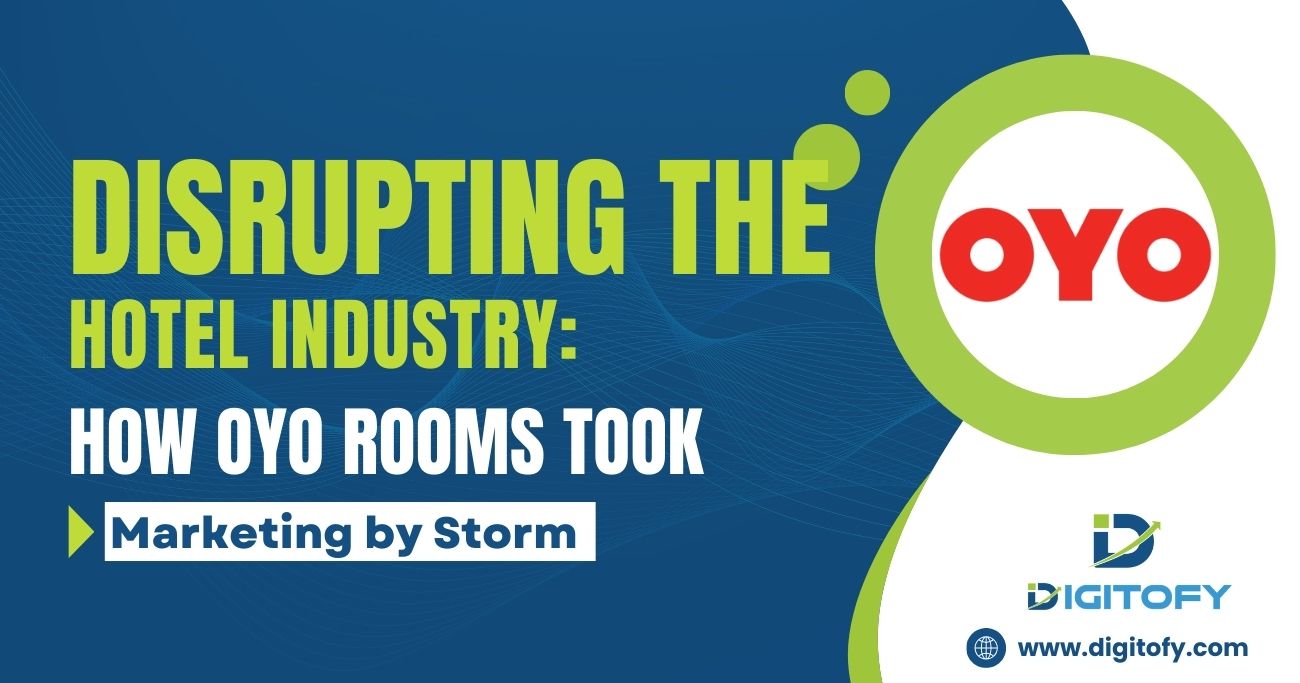Disrupting the Hotel Industry: How OYO Rooms Took Marketing by Storm
OYO Rooms is one of India’s largest hospitality chains, offering budget accommodations through its network of hotels and homes. Founded in 2013 by young entrepreneur Ritesh Agarwal, OYO has grown exponentially to become a major disruptor in the hospitality industry.
From just a handful of hotels in its early days, OYO now boasts over 43,000 hotels with more than 1 million rooms across 800+ cities in 80+ countries. This meteoric rise has been fueled by OYO’s innovative tech-first approach and some rather unorthodox marketing strategies.
Also, Watch Our YouTube Shorts Video on Day 66 – Disrupting the Hotel Industry: How OYO Rooms Took Marketing by Storm
About OYO Rooms
OYO Rooms (known simply as OYO) is an Indian hospitality chain of leased and franchised hotels, homes and living spaces. The company owns and operates a small number of hotels but mainly acts as an aggregator and franchisor of budget hotels under the OYO brand.
OYO operates on an asset-light business model. It transforms existing hotels through renovation and infrastructure upgrades to meet its brand standards. The company neither owns most of the hotel buildings nor is responsible for day-to-day management. Its main offerings are:
- OYO Rooms – Budget to mid-range hotels
- OYO Townhouse – Mid-range hotels with stylish accommodation
- OYO Home – Homestays and holiday homes
- OYO Life – Fully managed homes and apartments
- SilverKey – Business hotels and corporate stays
OYO’s lean and efficient operations have helped it scale rapidly in India and internationally even amidst the COVID-19 pandemic. It raised over $1 billion funding in 2020 to strengthen capabilities through technology.
Also Read: The Indigenous Marketing Strategy of Maruti Suzuki : The No 1 Car Company 🚗
What’s New with OYO?
Despite temporary setbacks from COVID-19 lockdowns, OYO has continued its ambitious global expansion in recent years:
- Launched operations in new markets like the Philippines, Mexico, Malaysia and more with over 43,000 hotels now listed on its platform
- Introduced innovative offerings beyond rooms – OYO Living for rental homes and OYO Life for fully-managed residences
- Implemented advanced smart room features powered by AI and IoT integrations
- Raised $660 million funding round in 2021 from global investors indicating strong confidence
- Signed a major partnership with Microsoft to co-create smart room experiences at affordable prices
- Increased focus on its vacation homes business seeing higher travel demand for nature escapes
- Piloting new ‘co-living’ spaces offering pay-per-use rooms with shared community areas
- Using big data analytics and revenue management tools to enable higher occupancy rates and returns for its hotel partners
Clearly, OYO is continuously evolving its business to tap into new opportunities while leveraging technology to enhance its offerings.
Also Read: From Local to Global: The Marketing Success Story of Red Tape Footwear
Buyer Personas
OYO targets two distinct buyer personas with tailored value propositions for each:
Budget Travelers
These are typically young travelers like college students, backpackers, family road-trippers, solo women travelers etc. looking for affordable and convenient stays while exploring new destinations.
Key attributes:
- Look for wallet-friendly accommodation without compromising on safety, hygiene or a decent night’s stay
- Value convenience and ease of booking a room, so rely heavily on apps/websites
- Often plan trips on a short notice so require flexibility in reservations
- Prefer places that provide basic comforts like WiFi, TV, breakfast, reliable water supply etc.
Business Travelers
The solo business travelers or corporate employees on work trips form OYO’s second key target audience.
Key attributes:
- Seek professional spaces to work remotely or conduct meetings
- Require amenities like laptop-friendly desks, printing solutions, conference rooms etc.
- Demand predictable standardized experiences across locations
- Have expenses reimbursed so mid-range prices are acceptable
- Rely on centralized corporate travel systems for booking
OYO caters to both buyer groups with tailored offerings. Now let’s examine the marketing mix powering OYO’s exponential growth despite such a short history…
Also Read: Revolutionizing Marketing: How MRF’s Strategy Made Them a 23,000 Crore Giant
OYO’s Marketing Mix
Behind OYO’s staggering rise is an innovative marketing strategy combining the latest tech with extensive grassroots engagement. Let’s probe the 4 Ps fueling their growth engine:
Product Strategy
Instead of creating a new hospitality product, OYO smartly decided to organize the highly fragmented budget hotel market in India. It gave budget hotels a standardized look, feel and experience customers could expect reliably under the OYO brand.
This helped address major pain points budget travelers faced earlier:
- Inconsistent hotel standards and uncertainty around the booking
- Poor amenities despite paying market costs
- Dealing with troublesome hotel owners during stays
OYO created a new hotel category called ‘budget branded hospitality’ that was non-existent earlier. It offered the predictability and modern amenities reserved for higher-end chains, at a budget price point.
Pricing Strategy
OYO utilizes smart data-driven pricing enabled by advanced revenue management systems and dynamic algorithms.
It analyzes demand patterns across micro-markets to optimize pricing in real-time to drive higher occupancy. Pricing is responsive to local conditions – increased during peak season and reduced to attract guests during low turnouts.
This omni-channel dynamic pricing helped OYO deliver on its core promise of guaranteed lowest rates to customers.
It passes on higher occupancy benefits from revenue management to customers through continued price cuts. This helped OYO undercut traditional hotels by:
- Maintaining margins via higher volumes on low base fares
- Lowering operational costs with tech and automation
OYO does not believe in supposedly affordable budget rooms that offer poor stay experiences. Instead, it delivers exceptional value at honest quality-conscious price points attractive to mass market segments.
Place Strategy
OYO utilizes an omni-channel distribution strategy making effective use of both online and offline channels.
OYO has a comprehensive digital presence to improve discoverability and enable self-service bookings:
- Website & Mobile App – Self-booking channels power majority bookings
- OTA Partnerships – Tie-ups with MakeMyTrip, GoIbibo, Booking.com etc.
- Social Media – Facebook, Instagram pages drive brand awareness & interest
The OYO app and website provide a seamless booking experience. Guests can easily check room options, compare prices and book rooms in just a few clicks.
Travelers increasingly prefer using apps to book hotels. Aligning with this trend, OYO now receives over 90% traffic directly on its platform. The online channel manages the entire customer journey – from discovery to booking to consumption and even payments.
Promotions Mix
OYO leverages both mass media promotions as well as influencer-driven advocacy for richer engagement:
- TV Commercials – Mass media campaigns around key seasons and events
- Outdoor Advertising – Visibility at airports, railway stations etc.
- Referral Programs – Customer referral schemes
But more unique are OYO’s cost-effective grassroots promotion channels:
- College Campus Programs – Campus ambassador initiatives targeting youth
- Branded Shop Conversions– Branding regular neighborhood shops as OYO points
- OYO Rooms on Wheels – Vans doubling up as moving billboards
Rather than mega ad spends, OYO invested in innovative low-cost engagement channels:
- College Campus Programs – It taps into vibrant campus clubs to promote exclusive student offers and build strong affinity among the next-gen of travelers.
- Branded Shop Conversions – OYO partners with local mobile recharge shops, transforming them into OYO Points outlets for booking assistance. Owners act as offline sales agents receiving commissions. This provides additional income to small shop owners while boosting OYO’s offline distribution.
Aligning with Indian consumers’ preference for offline engagement, these interactive ground activations create deeper brand engagement and recall. They enable OYO to penetrate India’s smaller towns rapidly and drive online conversions through localized network building.
Let’s now analyze how OYO positions itself among competitor brands vying for a share of this hospitality pie…
Also Read: Parle-G Ki Ultimate Marketing Strategy Jisne Ise Biscuit Ka Raja Bana Dia
Competitor Analysis
Though competition has intensified in recent years, OYO enjoys first mover advantage in organized budget hospitality with significant traction across India and abroad.
FabHotels
Founded in 2014, FabHotels is a competitor offering a standardized hotel network under a common brand targeted towards middle-income travelers. With 800+ hotels across India, FabHotels focuses more on the franchise model rather than leasing and operating hotels directly.
Treebo Hotels
Another prominent competitor, Treebo was founded in 2015 by ex-Flipkart executives. It positions itself as ‘India’s top business hotels brand’ operating 400+ properties offering smartly designed rooms, reliable amenities and a digital experience. But recent reports indicate Treebo has struggled with its model falling short of investment goals.
Now let’s examine the pillars of OYO’s marketing strategy powering its growth.
The X-Factor = Innovative Channel Partnerships
A key catalyst accelerating OYO’s early traction and visibility was strategic tie-ups with online booking partners and offline retail chains.
1. Tapping Online Travel Aggregators
Inking exclusive partnerships with major OTAs like MakeMyTrip gave OYO immediate digital discovery and booking access riding on existing user traffic.
RedSeer estimates OYO received nearly 100,000 room night bookings within just first year of launching due to MakeMyTrip partnership back in 2013.
This provided a vital initial spark for OYO to gain initial scale and customer exposure.
2. Strategic Offline Retail Alliances
OYO smartly tapped into offline retail chains frequented by its target audience.
- Partnerships with Cafe Coffee Day outlets and Ctrl-S cyber cafes to cross-sell OYO rooms
- Joining hands with GrabOn and Paytm for promotional offers driving app downloads
- Tie-up with IRCTC to enable train travelers to book OYO rooms at final destinations
These innovative retail alliances brought tremendous analog visibility while allowing prospects to discover the brand in natural contexts.
It drove strong synergy securing an additional acquisition channel through trusted retail partners of youth and working professionals.
Also Read: Tata Motors’ Disruptive Marketing Approach That Made Them Love of India
In Conclusion
From its early inception in 2013, OYO showed immense clarity in identifying and addressing precise customer needs using technology for delightful yet affordable stays.
Rather than fancy advertising, OYO invested in innovative product development and channel partnerships. It reimagined hospitality for the next-gen Indian traveler seeking quality, predictability and honesty.
These deliberate strategic choices engineered early traction despite limited advertising. And continue to propel OYO’s ascent as a rare budget hospitality pioneer from the East that won the west.
Related Post:
- How Country Delight Influencer Marketing Strategy Took Them to 500+ Crores
- How Chayoos Captured Gen Z’s Gen Y’s Audience with This Simple Marketing Strategy
- Dominos: How Their One Marketing Strategy Made Them the Largest Pizza Company in India
- Redbus: Dominating Indian Online Bus Booking Industry with this Digital Marketing Strategy
- Inside Shaadi.com – The Incredible Marketing Strategies Behind Their Success
- Octave: From Ludhiana to a 250 Cr Brand – How They Captured the Youth Attention

.webp)

